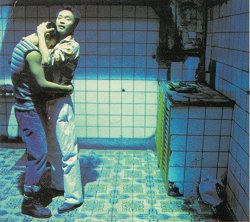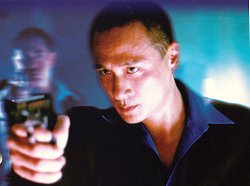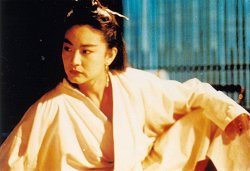"If the best thing about Bulletproof Monk is its snappy title – and it is – the most surprising thing is that the dialogue is in English. Though made for a major studio with a recognizable cast, it is hard to differentiate it from the standard-issue Hong Kong-style dubbed programmers that first introduced the martial arts to American audiences."
Kenneth Turan, from his review of Bulletproof Monk
Over the last ten years, as Hollywood has seen an influx of Hong Kong talent fleeing the colony’s own impoverished industry, the "Hong Kong movie" has moved from fringe status to its own genre, referenced by film buffs, professional critics and academics alike. In the Kenneth Turan quote given above, Turan seems to express a measure of disdain, but is unclear on his personal definition: What exactly is a "standard-issue Hong Kong-style dubbed programmer"? On the surface this would seem to refer back to the chop-socky days of the 1970s, when martial arts films by such companies as Shaw Brothers were routinely imported into the American market and dubbed to provide cheap fare for downtown (and often largely ethnic) audiences hungry for action. And yet surely Turan can’t be comparing a 2003 release – with high-tech effects and established actors – to films from thirty years ago? Is he, perhaps, actually referring to more recent releases such as Jackie Chan’s Supercop (aka Police Story 3) or The Legend of Drunken Master (aka Drunken Master II), which received American releases in dubbed form? If so, the comparison reveals an even greater contempt on Turan’s part, since both Supercop and Drunken Master II were (especially in their original forms) equally pleasing to both audiences and most critics.
Or is it possible that a critic as established and experienced as Turan simply isn’t sure himself what he’s talking about? Most Westerners persist in thinking of "Hong Kong movies" as Saturday-matinee fare, good for a quick jolt of kung fu adrenaline but lacking in any substance or art; the more enlightened might  know of John Woo’s Chinese-language films, and reference those as well. Some may even have seen such arthouse films as Wong Kar-wai’s Happy Together or In the Mood for Love, although they’d be unlikely to consider those "Hong Kong movies".
know of John Woo’s Chinese-language films, and reference those as well. Some may even have seen such arthouse films as Wong Kar-wai’s Happy Together or In the Mood for Love, although they’d be unlikely to consider those "Hong Kong movies".
They should.
The broader definition of "Hong Kong cinema" is recognized by only a select few Westerners, principally film scholars (in the U.S., principally David Bordwell) and Asian film fans who congregate at film festivals and internet forums. Although many of the fans approach Hong Kong cinema in the same way that they approach American exploitation cinema (lurid shockers such as Naked Killer are exalted by this group), many are as interested in the latest comedy or drama from the Hong Kong Special Administrative Region (HKSAR). These aficionados have favorite actors and directors, buy books on the subject, make shopping trips and pilgrimages to the HKSAR – and even they are likely to be stumped if asked to define what sets Hong Kong cinema apart.
In his full-length examination of the aesthetics of Hong Kong cinema, Planet Hong Kong: Popular Cinema and the Art of Entertainment, David Bordwell calls this "...arguably the world’s most energetic, imaginative popular cinema." Bordwell goes on to explore the importance of economics, history, and film technology in creating the region’s films. He explores, for example, the tradition of "segment shooting", a style of cinematography and editing that arose (of necessity) from the martial arts cinema. The western way of blocking, shooting and cutting a scene is one of master/close-up – any scene begins with a wide shot, then cuts in for close-ups of the actors, typically in what Bordwell refers to as an "ABAB" rhythm. This is the perhaps the most basic filmographic technique taught to western film students, and has become the accepted basis for American filmmaking.
In martial arts films, however, the master/close-up model is untenable, since a complex combat sequence cannot be shot in a single wide or master shot; each move must be carefully choreographed and just as carefully filmed. This means the camera is repositioned for each part of the fight; the same angle is seldom used twice. "Segment shooting" became so popular that it spilled over into non-fight scenes, and is one factor in the unusual look and pace of Hong Kong films.
However, the unique qualities of Hong Kong films may owe as much to age-old philosophy as contemporary styles and technologies. King Hu, director of the classics A Touch of Zen and Come Drink With Me (and perhaps the single most influential Hong Kong filmmaker), suggested that western arts stemmed from a philosophy (first expounded by the Greeks) of conquering nature, whereas eastern arts expressed a desire to live in harmony with nature. Both King Hu and Zhang Che (The One-Armed Swordsman, Vengeance!) cite Peking Opera as a major influence; in fact, King Hu claimed "I have no knowledge of kung fu whatsoever."

Although King Hu’s own films – with swordsman who gracefully execute such astounding leaps and flights that they could only be in close harmony with gravity – reflect this philosophy (as does much of Tsui Hark’s work), this notion of eastern philosophy as a central tenet of Hong Kong cinema fails when applied to such classic Hong Kong films as Johnnie To’s The Mission or John Woo’s A Better Tomorrow. In the urban drama or thriller (which makes up a considerable percentage of the HKSAR’s recent cinematic history), man’s relation to nature is limited to how long the heroes can stand after taking a clipful of bullets.
What, then, does define Hong Kong cinema? Here (in no particular order) are the most basic factors:
The Story. Hong Kong films have a special ability to present stories – no matters how many cliches they may recycle – in ways that continually surprise, delight and shock. Heroes may die, antagonists may become protagonists, genres may be jumped mid-film, and children – those most sacred creatures in western culture – can be victims or killers. The three-act structure taught in every Hollywood writing class and adhered to by the major studios is usually nowhere to be found in a Hong Kong film; characters don’t need to evolve, experience "arc" or redemption by story’s end. While this refusal to employ traditional western storytelling techniques can lead to confusion and implausible logic, it also makes Hong Kong films seem fresh and exciting.
If Hollywood cinema has evolved based on a business model of building on former successes, Hong Kong’s industry seems to have employed the notion that emphasis is better given to exploring new products. Certainly Bordwell is correct in suggesting that this willingness – indeed, this desperation – to explore new stories and ways of telling those stories derives from the HKSAR’s peculiar economic and social history. The HKSAR itself is only 415 square miles, but its residents are among the most movie-loving people on earth, with some surveys suggesting that they see nearly twice as many movies each year as their American counterparts. Not only are Hong Kong movies, then, competing within a small geographical location, but they’re also competing against American, Japanese, Korean, Taiwanese and other imports. Without any form of government subsidy, but with plentiful cheap labor, Hong Kong movies are shot quickly and inexpensively; budgets are a fraction the size of American product, and don’t allow for grandiose sets or rampant special effects.
What this all means is that Hong Kong filmmakers know they have to tell stories imaginatively, with the assets they do have (cinematography, fight choreography, acting, music), and that they must capture and hold their audience in a highly competitive market.
In recent years, Hong Kong filmmakers have experimented more and more with the form and structure of their films. Long before western critics were praising the novelty of Memento’s backwards storytelling, directors like Wong Kar-wai (Ashes of Time), Ann Hui (Ordinary Heroes), Wai Ka-fai (Too Many Ways to Be Number One) and Cha Chuen-yee (Once Upon a Time in Triad Society) had all told nonlinear stories.
Hong Kong’s cinema also makes use of storytelling traditions that are centuries old. The triad gangster fighting for honor, or the martial arts master fighting for "face" all date back to a grand history of swordplay and martial arts literature. Whereas American heroes typically fight either to protect a woman or to accomplish a mission, Chinese heroes fight for grander principles: Family or respect. Family, especially, is a far more intrinsic value in Chinese culture, and even in such contemporary films as Johnnie To’s Running Out of Time or Tsui Hark’s Time and Tide, the protagonists are acting on behalf of family. While more jaded western viewers may find themselves scoffing at the notion of upholding the honor of one’s father, there’s no denying that family is one of the great universals of human existence, and Hong Kong cinema recognizes that fact and exploits it beautifully.
And although it’s commonly accepted that Hong Kong movies are almost completely lacking in strongly-stated political or social points-of-view, the territory’s peculiar political history (mainly the 1997 handover from Britain to China) has given the region’s films a rich subtext for twenty years. Films such as Johnnie To’s 1988 potboiler The Big Heat positively twitched with anxiety about the coming Handover (the film’s villains are out to make as much cash as they can before ’97); other films, like the Tsui Hark-produced The East is Red (1993), dealt with Hong Kong’s pre-Handover anxieties via metaphor and allusion. Even relatively lesser films such as Killers From Beijing (2000) or the bizarrely-titled King of Debt Collecting Agent (1999) used contemporary social issues to evoke tension or (in the case of the latter film) comedy.
The Actors. Peking Opera had more effect on Hong Kong cinema than just philosophy – it may be the biggest difference in the acting styles of east vs. west. American film actors have relied largely on the Method for half-a-century now; the Method emphasizes the individual actor’s motivations over the greater needs of telling the story, and has transformed not just western acting but also western cinematography, dictating more close-ups.
In the east, however, the Method remains virtually unknown; instead actors draw on either the broad, physical styles of Peking Opera or the intuitive shorthand necessitated by ridiculously-short shooting schedules. Actors aren’t paid the absurd wages of their American counterparts; superstars such as Andy Lau were commonly known to shoot several films at once, driving from one location to another and catching naps inbetween (Samson Chiu’s hilarious 2002 hit Golden Chicken even pokes fun at this idea, when the heroine, a prostitute, enters a massage parlor room only to find Andy Lau himself, simply begging her to be quiet so he can sleep). Being forced to work more gave stars not just experience but also the chance to expand their range; Golden Chicken’s star Sandra Ng, for example, is an award-winning performer for both comedy (i.e., a Best Actress nomination at the Hong Kong Film Awards for Golden Chicken) and drama (she won the award for her portrayal of a triad boss in 1998’s Portland Street Blues). In the United States, Chow Yun-fat has been cast largely in action and martial arts films, but in Hong Kong he was equally known as a romantic leading man and comic performer.
Hong Kong films, until very recently, were typically shot without synch sound, meaning that actors were forced to convey emotions visually. The disadvantage to this system was that actors seldom dubbed their own dialogue, and there was often an irritating disparity between the performer’s physical appearance and the voice chosen to go with them. The upside (although many Americans found the style too bizarre) was that performances were rendered in grand strokes of emotion, not unlike American silent acting techniques. Terence Chang, a major behind-the-scenes figure in Hong Kong’s film business, referred to new Hong Kong star Daniel Wu as having "body language [that is] totally American", underlining the fact that Hong Kong’s own actors have a distinctively-eastern posture and carriage. After years of watching American Method-trained actors slouch and posture, the Hong Kong performer’s exquisite bearing and dignified grace can seem nothing less than revelatory.

Hong Kong movies can also make better use of women and question gender roles in more subversive ways than their western counterparts. Chinese literature and history is a wealth of contradictory views on women – they can be warriors who are easily the equal of men, or they can be virtual slaves in their own families. Hong Kong cinema has provided some of the most glorious roles for women of any national cinema, and has filled those roles with actresses of astonishing grace, beauty and talent. Even films emphasizing masculine themes and characters, such as Stephen Ciao’s Shaolin Soccer or Dante Lam’s Jiang Hu: The Triad Zone feature female leads who are smart, strong and unusual. Hong Kong films have even gone so far as to suggest that women can be more powerful than men, whether by claiming traditional male roles (Corey Yuen’s 1985 cop movie Yes, Madam ), or by offering up men who transform themselves into women (Tsui Hark and Ching Siu-tung’s Swordsman II).
The Photography. Hong Kong films feature camera angles found nowhere else on the planet, and colors that are dazzling, with truly-scarlet reds and neon blues. Although there may be technical reasons for this (many Hong Kong movies have been shot on a Fuji film stock not commonly found in the U.S.), more likely the reason goes back again to competing for audiences. While American films have come to pride themselves on their desaturated color usage (which dates back to the 1970s, when it was effectively used by William Friedkin for The Exorcist and John Boorman for Deliverance), and Japanese films seem to become darker and more static, Hong Kong films persist in their color-drenched, fast-moving compositions. Freed from the necessity to compose shots around the placement of the boom mike (used when recording synch sound), Hong Kong cameras swoop, hover, glide and rush; in Wai Ka-fai’s Too Many Ways to Be Number One, they even turn upside-down for entire sequences. Hong Kong’s filmmakers, probably beginning with Zhang Che and King Hu and continuing through to John Woo and Tsui Hark, have perfected the use of slow-motion to draw out suspense or punch up emotional moments.
In the late 60s and 70s Hong Kong films could be distinguished by their use of the fast zoom-in; however, despite the fact that the zoom could be put to good use by such directors as Zhang Che, it was eventually overused and has been largely abandoned.
The Editing. Western critics tend to cite fast editing as a Hong Kong movie attribute, and in this case they’re right. John Sham has told an anecdote about Tsui Hark’s editing style, that after his initial assemblage of a scene he went back in and simply removed frames from the beginning and end of every shot. As noted above, Hong Kong films (because of segment shooting) employ a greater number of cuts than American films, and flashbacks are often used to great effect. Certain Hong Kong films knowingly break commonly-accepted rules of editing: For example, in 2002’s So Close, director Corey Yuen and editor cross lines of direction in a key fight sequence to emphasize the fight’s chaotic blows and energy.
So, to ask again: What is Hong Kong cinema? Is it possible to come up with a definition? Certainly no single definition can encompass the region’s entire cinematic output, but in general: Hong Kong films feature stories told in fresh and unconventional ways, sometimes with nonlinear narrative structure; they offer performers who are glamorous and passionate, and women often figure as prominently as men; they use color and camera movement to heighten pace and emotion; and the films are often edited with many quick cuts and ingeniously-placed flashbacks.
There’s one final element that should be taken into account, and it’s this: Hong Kong films convey great joy or love of the filmmaking craft. The region’s film artists (who work for salaries that are infinitesimal in comparison to those of Hollywood’s craftsmen) seem to be simply in love with the art form we call movies, and this love expresses itself in their vibrant, beautifully-made and moving moving picures. If American films of the last two decades have become bogged down by an increasingly reliance on demographics in place of art or passion, Hong Kong’s movies still offer a cinematic sanctuary for movie-lovers on both sides of the camera.
SOURCES:
Bordwell, David, Planet Hong Kong: Popular Cinema and the Art of Entertainment, Harvard University Press, Cambridge: 2000
Chute, David, "The Asian Evasion", Premiere magazine
Lau Tai-muk, "Conflict and Desire - Dialogues Between the Hong Kong Martial Arts Genre and Social Issues in the Past 40 Years", from The Making of Martial Arts Films - As Told by Filmmaker and Stars
The Incredibly Strange Film Show (Tsui Hark segment)
The Making of Martial Arts Films - As Told By Filmmaker and Stars, Provisional Urban Council, Hong Kong: 1999
Morton, Lisa, The Cinema of Tsui Hark, McFarland and Co., Jefferson, North Carolina and London: 2001
Turan, Kenneth, "Bulletproof a lot of monk business", Los Angeles Times, April 16, 2003